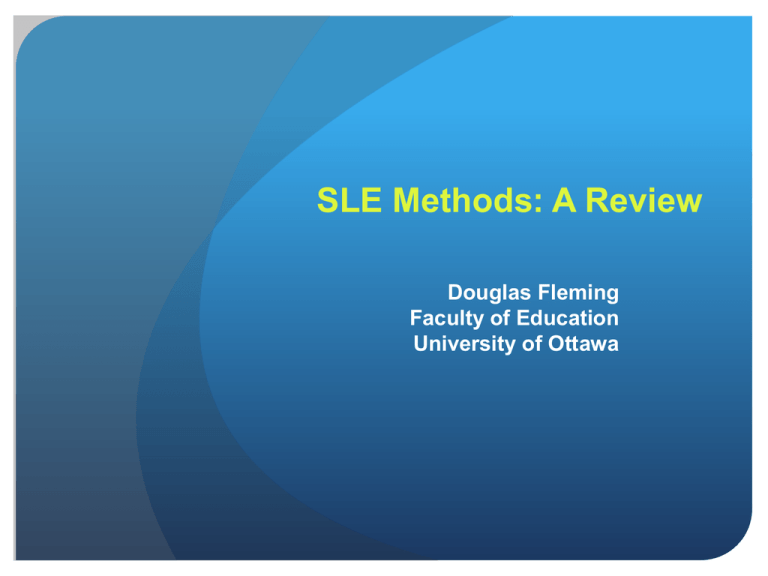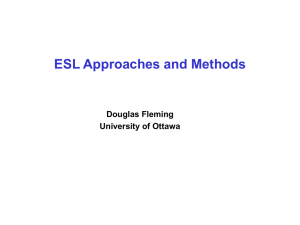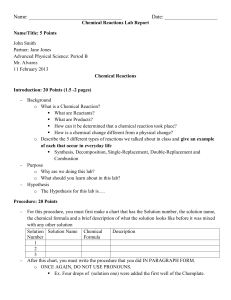Placing the Cognitive Approach in the Context of Current and
advertisement

SLE Methods: A Review Douglas Fleming Faculty of Education University of Ottawa Pendulum Swings in the Field “our field has been afflicted with many false dichotomies, weak conceptualizations, and neglect of critical issues and variables” (Carroll, 1965, p. 102) Method, Approach and Technique an approach is one’s assumptions and beliefs about language and teaching; a method is the pattern with which you make pedagogical choices based on your approach; a technique is a specific set of activities for the classroom based on your preferred method. based on Anthony (1963) Grammar Translation • formal codification commonly attributed to Erasmus (1466-1536); • developed out of the ecclesiastic use of Latin; • adopted by educated and class elites; • centered on the memorization of verb forms, grammar rules, and vocabulary; • methods concentrated on: • the translation of literary texts; • comprehension questions following a text; • teacher-centered activities. Audio-lingual Approach • originated out of the U.S. ‘Army Method’; • based on the behaviorist belief that language learning consists of habit formation; • communication and context not emphasized; • purpose of language use for learner not judged to be important; • features repetitive drills and memorization of dialogue; • emphasis placed on pronunciation; • activities usually teacher-centered. Designer Methods a multitude of techniques developed by specific curriculum and materials designers in the 1960’s-1980’s; often spawned dogmatic attitudes (and profitable educational empires); most were based on the pop-psychology of the time; examples include: • Total Physical Response • Suggestopedia • The Silent Way Criticisms we need to discard simple formulas (Stern, l983) tensions exist between conceptions of teachers as a) technical implementers of fully developed curricula and b) fully developed professionals (Pennycook,1989) singular methods are irrelevant to most practice (Nunan, 1991) Stephen Krashen • one of the best known applied linguists today; • often (justifiably) criticized for being pseudo scientific; • legacy has been important if only for the way he forced the field to deal with long ignored fundamental issues and contradictions. hypotheses Acquisition/ Learning Hypothesis Monitor Hypothesis Natural Order Hypothesis Input Hypothesis Affective Filter Hypothesis (1981) Second Language Acquisition and Second Language Learning The Communicative Approach the most commonly accepted methodology today; concentrates on function rather than form; as Allen and Widdowson (1979) stated, the approach involves, "the learning of rules of use as well as rules of grammar" (p.141); the goal is to create a realistic context for language acquisition in the classroom. functional language usage; the ability of learners to express their own ideas, feelings, attitudes, desires and needs. open ended questioning and problem-solving activities and exchanges of personal information are commonly utilized; students usually negotiate meaning while working with authentic materials (realia) in small groups activities; associated with pedagogical tasks (Johnson, 1979) Expanded Notions of Language Canale and Swain’s (1980) model of communicative competence: linguistic socio-cultural strategic discoursal Expanded Notions of Pedagogical Options Stern’s (1983) teaching strategies: crosslingual vs. intralingual objective vs. subjective explicit vs. implicit the most fundamental question still remains: what is the relationship between explicit knowledge of the language and actually using it? Ellis (1997) identified 3 positions in the research: - Strong Interface Position (Biaystok, McLaughlin, Sharwood-Smith) - Non-Interface Position (Krashen, Terrell) - Weak Interface Position (Ellis, Long, Selinger) Weak Interface Position explicit instruction is a ‘consciousness-raising’ activity the enhances input: 1) for comprehension, helping the learner to intake (recognise and understand features of the input) 2) for explicit knowledge, helping a learner learn about the structure metalinguistically facilitates ‘noticing’ and ‘noticing the gap’ helps combine structured syllabi with those that are functional or task based Focus on Form grammar is heterogeneous and it is important to mix explicit and implicit techniques depending on the grammar item, the communicative task and the learner involved (Kennedy, 2004); in a sense, this is a compromise between the strong and the non-interface positions outlined earlier; moves past the sterile phonics/ whole language debates; represents the basic theoretical background justifying such structured techniques as AIM, Balanced Literacy and Smart Learning. See forthcoming TESOL Quarterly Special Issue (edited by Nasarji) Implications learners: should become less dependent on rote learning and more adept at understanding and manipulating linguistic forms in actual communication. teachers and curriculum writers: should exercise professional agency in the interests of a balanced and thoughtful approach to curriculum development, lesson planning and task design





